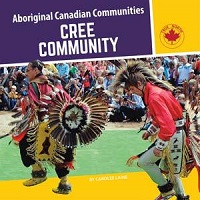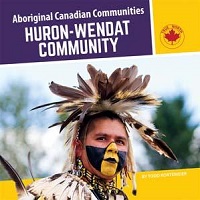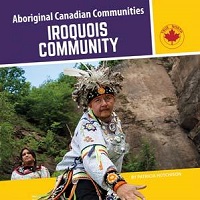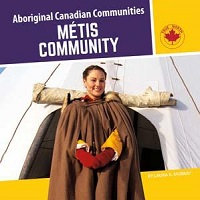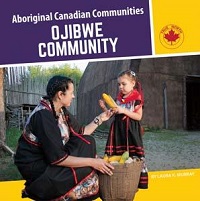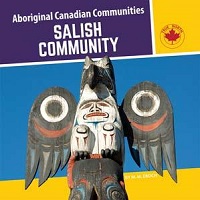| ________________
CM . . .
. Volume XXIII Number 15. . . .December 16, 2017
excerpt:
Past and present come together in this six-volume series entitled “Aboriginal Canadian Communities”. Each book is divided into four chapters which cover topics such as history, settlement, homes, food, tools, transportation, laws and treaties, traditions and modern ways. The information is very general and often vague, lacking the detail required to engage and inform readers. For example, the text states that the specific Aboriginal community shared spiritual beliefs and stories, yet other than mentioning shamans, there is no explanation about the Great Spirit or Creator, animal spirit guides or the Seven Sacred Teachings, nor are there examples of creation or trickster myths and legends. There is much focus on land rights, treaties and residential schools, but this information is lengthy and, though important, is likely to be of little or no interest to such a young audience. Perhaps this section could have been shortened somewhat. Where certain articles of traditional clothing or types of crafts and tools are discussed, it would have been beneficial to have some photographs or drawings of those items. The text is written in short, clipped sentences, fine for a young audience, but the illustrations (maps, black and white archival photographs and colour photos) could have been more plentiful and relevant. Each title has an Inquiry Question which invites readers to reflect on a part of the text One example is: “Why did students have to attend residential schools? How would you feel if you were forced to leave your family and learn a new language and new customs?” There are also several “Say It” boxes throughout each title with words or phrases from the specific Aboriginal language. The words are written in English with the pronunciation provided. A table of contents, a glossary, an index and a brief list of books and websites for further study are included. There are five major Cree language groups, each with their own traditions and cultures. In Cree Community, readers will learn about the various groups and where they settled, as well as the daily life of both the Woodland and Plains Cree. The fur trade played a major part in the lives of the Swampy and Woodland Cree people who were expert trappers. In the description of the Walking-Out Ceremony, the author states that in a ceremonial tent “the elders give the children hunted animals that have been decorated”. When the children leave the tent, they pull the animals behind them. Does this mean that the children are given animal skins or the actual animals? The author also mentions the beautiful paintings and beadwork done by the Cree as well as the stories, songs, dances, games and feasts, but, with the exception of a photograph of a girl wearing traditional dress with some beadwork on it, nowhere are any of these shown or described in more detail. The St. Lawrence Valley between Lake Huron and Lake Ontario was the original area settled by the Huron-Wendat people. Today there is only one reserve left, and it’s located in Quebec City. Huron-Wendat Community showcases the traditional life of the people who lived in longhouses in villages of 900-1,600 members and farmed the land. They were also expert canoe makers. Powwows and feasts, such as the Green Corn Festival (to give thanks for the harvest) and the Feast of the Dead (to allow souls to move on together into the afterlife) are important traditions. Southern Quebec, Ontario and parts of the United States were home to the Iroquois. A village was comprised of 30-50 longhouses, each of which held an entire clan. Iroquois Community discusses some of the seasonal celebrations, such as the Maple Tree Ceremony, and mentions lacrosse as one of the contributions made by this group. One of the well-known art forms is masks made from corn husks or carved from wood. Unfortunately, no photographs of these masks are included in the book. Blending European and First Nations traditions, the Métis community thrived in the area near the Red River but now can be found in almost all parts of Canada. The people followed the bison and grew corn and beans, Métis Community highlights, among other things, the music and artwork created by the people. From making music with fiddles and spoons to enhancing clothing with dyed porcupine quill embroidery and woven sashes, the Métis were also known for their braided rugs and baskets. Other than the sashes, none of the other crafts is shown. Originally from the forests of the Great Lakes, the Ojibwe migrated to the prairies. They were trappers and fishers, harvested wild rice and tapped maple trees for the syrup. In Ojibwe Community, readers will also learn about the homes (wigwams), the many uses of plants for food and medicine, and the purpose of a vision quest. Salish Community features the Aboriginal people who settled in southwestern Canada and the northwestern United States. Known for their fishing prowess, especially for salmon, the Coast Salish lived in longhouses built near the water. Interior Salish lived in pit houses, deep pits in the ground covered with cone-shaped roofs. The Salish are known for their cedar bark mats as well as their canoes which could be 15 metres long and hold 50 people and 4,500 kilograms of fish. In this title, there is also brief information about a potlatch. Too pricy, too general and lacking in relevant photographs, this series will not be of much use in the classroom. Not Recommended. Gail Hamilton is a former teacher-librarian in Winnipeg, Manitoba.
To comment
on this title or this review, send mail to cm@umanitoba.ca.
Copyright © the Manitoba Library Association. Reproduction for personal
use is permitted only if this copyright notice is maintained. Any
other reproduction is prohibited without permission.
Next Review | Table of Contents For This Issue - December 16, 2016 |
